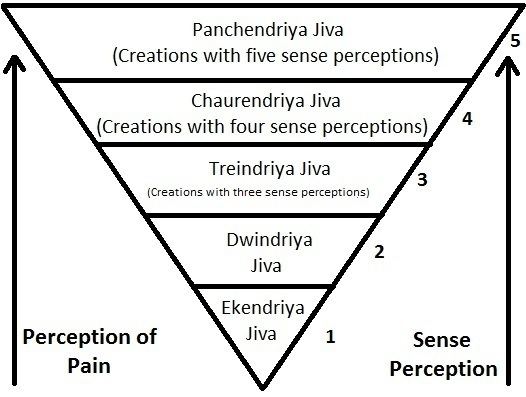 | ||
Jain vegetarian diet is practiced by the followers of Jain culture and philosophy. It is one of the most rigorous forms of spiritually motivated diet on the Indian subcontinent and beyond. The Jain cuisine is completely vegetarian and also excludes onions, potatoes, brinjals (eggplants) and garlic, similar to the shojin-ryori Buddhist cuisine of Japan.
Contents
The strictest forms of Jain diet is practiced by the ascetics; in addition to potatoes it may exclude other root vegetables. This food is called sattvic, which means that it is based on the qualities of goodness, lightness and happiness. On the other hand, onions, eggplant and garlic are considered "tamasic", as they are believed to have a quality of darkness, lethargy and a putrid smell.
Jain objections to the eating of meat, fish and eggs are based on the principle of non-violence (ahimsa, figuratively "non-injuring"). Every act by which a person directly or indirectly supports killing or injury is seen as act of violence (himsa), which creates harmful reaction karma. The aim of ahimsa is to prevent the accumulation of such karma. The extent to which this intention is put into effect varies greatly among Hindus, Buddhists and Jains. Jains believe nonviolence is the most essential religious duty for everyone (ahinsā paramo dharmaḥ, a statement often inscribed on Jain temples). It is an indispensable condition for liberation from the cycle of reincarnation, which is the ultimate goal of all Jain activities. Jains share this goal with Hindus and Buddhists, but their approach is particularly rigorous and comprehensive. Their scrupulous and thorough way of applying nonviolence to everyday activities, and especially to food, shapes their entire lives and is the most significant hallmark of Jain identity. A side effect of this strict discipline is the exercise of asceticism, which is strongly encouraged in Jainism for lay people as well as for monks and nuns. Out of the five types of living beings, a householder is forbidden to kill, or destroy, intentionally, all except the lowest (the one sensed, such as vegetables, herbs, cereals, etc., which are endowed with only the sense of touch).
Practice
And, how can one who eats food without the light of the sun, albeit a lamp may have been lighted, avoid hiṃsā of minute beings which get into food?
Wine deludes the mind and a deluded person tends to forget piety; the person who forgets piety commits hiṃsā without hesitation.
Influence on vegetarian cuisines in India
The vegetarian cuisines of some regions of the Indian subcontinent have been strongly influenced by Jainism. These include
In India, vegetarian food is considered appropriate for everyone for all occasions. This makes vegetarian restaurants quite popular. Many vegetarian restaurants and Mishtanna sweet-shops –- for example, the legendary Ghantewala sweets of Delhi and Jamna Mithya in Sagar –- are run by Jains.
Some restaurants in India serve Jain versions of vegetarian dishes that leave out carrots, potatoes, onions and garlic. A few airlines also serve Jain vegetarian dishes upon prior request. The term satvika often implies Indian cuisine without onions and garlic; strict Jain cuisine also excludes other root vegetables like potatoes.
Historical background
When Mahavira revived and reorganized the Jain community in the 6th century BCE, ahimsa was already an established, strictly observed rule. Parshvanatha, a tirthankara whom modern Western historians consider a historical figure, lived in about the 8th century BCE and founded a community to which Mahavira’s parents belonged. Parshvanatha’s followers vowed to observe ahimsa; this obligation was part of their caujjama dhamma (Fourfold Restraint).
In the times of Mahavira and in the following centuries, Jains criticized Buddhists and followers of the Vedic religion or Hindus for negligence and inconsistency in the implementation of ahimsa. In particular, they strongly objected to the Vedic tradition of animal sacrifice with subsequent meat-eating, and to hunting.
According to the famous Tamil classic, Tirukkuṛaḷ, which is also considered a Jain work by some scholars:
256. If the world did not purchase and consume meat, no one would slaughter and offer meat for sale.
Some Brahmins –- Kashmiri Pandits, Bengali Brahmins and Saraswat Brahmins –- have traditionally eaten meat (primarily seafood). However, in regions with strong Jain influence such as Rajasthan and Gujarat, or strong Jain influence in the past such as Karnataka and Tamil Nadu, Brahmins are strict vegetarians. Bal Gangadhar Tilak has described Jainism as the originator of Ahimsa. He wrote in a letter:
In ancient times, innumerable animals were butchered in sacrifices. Evidence in support of this is found in various poetic compositions such as the Meghaduta. But the credit for the disappearance of this terrible massacre from the Brahminical religion goes to Jainism.
Some scholars state that ancient Jain ascetics accepted meat as alms if the animal had not been specifically killed for them. If this is correct, then they applied the same standard as early Buddhists. Some passages in two of the earliest Śvētāmbara texts, the Acaranga Sutra and the Dasaveyaliya, have been interpreted as regulations for specific types of meat and bones which were considered acceptable alms. This can also be interpreted as references to fruits and seeds. Medieval Jain commentators on these passages interpreted them in the literal sense, but also mentioned the opinion that the offensive words had different meanings, some of which did not refer to animals and hence were compatible with vegetarianism. Modern Jains, who are strict vegetarians, prefer the latter interpretation of these scholars on this matter.
